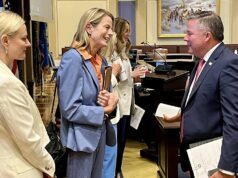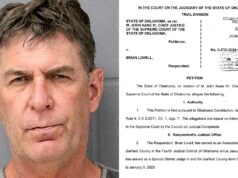
The sight was something to behold: a two-mile-long line of people stretching across the three lanes of Lincoln Boulevard, en route to the Oklahoma State Capitol building. Cars passing on the other side of the street honked while the drivers hooted and hollered their support, but the line itself was not the spectacle. The group of high school students leading the charge was.
The students’ passion was palpable and electrifying. It could be felt through every syllable they shouted into their megaphones. After so many years of older generations telling them about their self-entitlement and obsession with instant gratification, these students put their money where their mouths are by participating in some good old-fashioned civil disobedience in protest of something they deem important: an end to mass shootings across the United States.
National issue spurs local action among teens
The March For Our Lives movement is a grassroots movement that caught fire in the aftermath of the school shooting Feb. 14 at Marjory Stoneman Douglas High School in Parkland, Florida. It wasn’t until Jamie Pool, an 18-year-old senior at Sallisaw High School, noticed the lack of a local march that the movement came to OKC.
“I was in my English class when the notification from CNN [about the shooting] came up on my phone,” Pool said. “I just felt sick to my stomach. I didn’t get upset until later, though, when I started seeing the photos of the victims and watching the interviews with students from Stoneman Douglas. That’s when I really got sad and angry.”
But these are the kids who have been forged in the fires of a social media-driven world. They know the power of raised voices in an online space in order to mobilize, organize and execute an event of this caliber.
“I decided to organize the OKC march the night that the national march was announced. I waited a couple of hours to see if one would pop up, and it didn’t, so I texted a friend of mine who I thought would be interested. He said he’d love to organize the march with me, and now we’re here,” Pool said.
From there, things happened very quickly. Pool was connected with T. Sheri Dickerson, who was one of the lead organizers of the OKC Women’s March in January of 2017.
“My experience with this march has been an eye-opening one for sure,” said Brennan Bratcher, another march organizer from Yukon High School. “Of course, there has been some backlash and hate thrown our way, but what can you expect? There has also been an overwhelmingly positive side of the feedback, especially from the adults. We can’t thank the supporters enough.”
Teen organizer Daren Malone: ‘We are the future!’

At the Oklahoma County Election Board parking lot Saturday morning, there were rows upon rows of tables for participants to register to vote, grab T-shirts and make or purchase signs to show solidarity for the movement during the trek to the Capitol. There were even people walking around with snack bins and trash bags as everyone gathered to protest an issue that the American people have been dancing around for decades.
“All of the great revolutions have started with our youth,” Dickerson said, standing atop a truck bed surrounded by the organizers and protesters before handing the megaphone over to organizer Daren Malone.
As Malone brought the megaphone to her lips, it was as if the crowd took a collective breath and scooted forward, eager to absorb the words she was about to say. Her rousing two-minute speech citing the multiple victims of gun violence and the lives they should be leading – had they not been cut so short – and the change that is inevitably coming was like throwing a lit match onto dry summer grass.
“We are marching for every nightclub, concert, church, movie theater and neighborhood affected by gun violence,” said Malone. “Adults today think of this generation as a bunch of social media-addicted teenagers who know nothing about this world, but I promise you one thing: We are the future!”
Her speech left me and many others teary-eyed. The crowd erupted as the flame was ignited, and it occurred to me that these kids, much like many of my own former classmates, have grown up in a world where mass shootings have become a sickening norm. I’ve become so desensitized, I can’t even remember a time when mass shootings were a foreign occurrence. I only have secondhand stories from my parents and older family members who remember when Columbine happened and how shocking an event it was.
Although many of us cannot grasp a world where these tragedies are things of the past, the March For Our Lives students know that a future where they are is possible, and the protest on Saturday was bubbling over with this hope. Every step closer to the Capitol was a step closer to gun reform.
“I hope we wake our legislators up. I hope we show them that we aren’t stopping. I hope they realize common sense gun laws are needed, and the time is now because we have all had enough,” said organizer Bratcher.
‘We have had enough’
The rally at the Capitol was filled with more speeches about how this movement is long overdue (to much-thunderous applause), and a course of action was set: Vote out the legislators who don’t agree with common-sense gun laws.
But for Pool, Bratcher and the other organizers, they told me their fight is far from over.
“Many members of our team are too young to be able to vote in November, but those of us who can will definitely be hitting the polls,” Pool said. “Several of us are going to continue working with Moms Demand Action and Students Demand Action as well. We will continue calling and writing our legislators, plan more protests if we need to and just continue the fight till we see it through.
“We’ve all got voices, and if you don’t feel like you have the opportunity to use yours, make an opportunity. Connect with people with the same ideas and dreams as you. Together, you can change the world. It sounds cheesy, but it’s true. Sometimes you just have to put on your bravest face, stand up, and say ‘Enough is enough.’ It’s up to all of us now.”
Bratcher agreed.
“After the march, I plan on still advocating for common-sense gun reform until it happens,” he said. “I don’t want my children having to beg legislators to care about their lives over NRA money like I and many other students are.”
“‘When your leaders act like children, and your children act like leaders, you know change is coming.’ That has been my motto since the beginning of this movement,” said Bratcher. “I saw it one day on Twitter and fell in love. To the legislators who aren’t listening: Your time is running up. I hope you enjoy retirement. To the NRA: Your days of controlling legislators, bills being passed and the safety of children are coming to an end. We have had enough.”





















